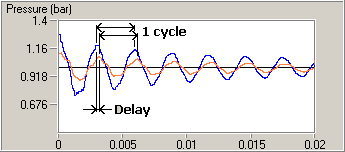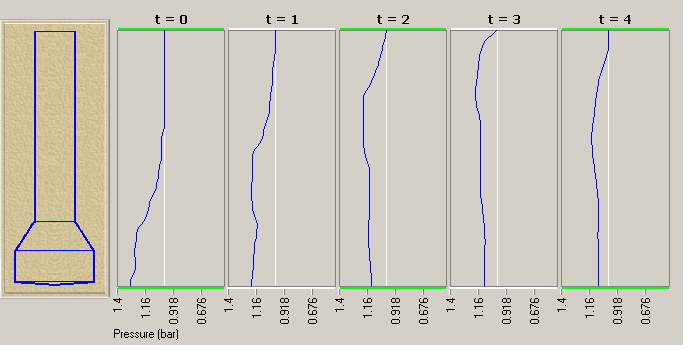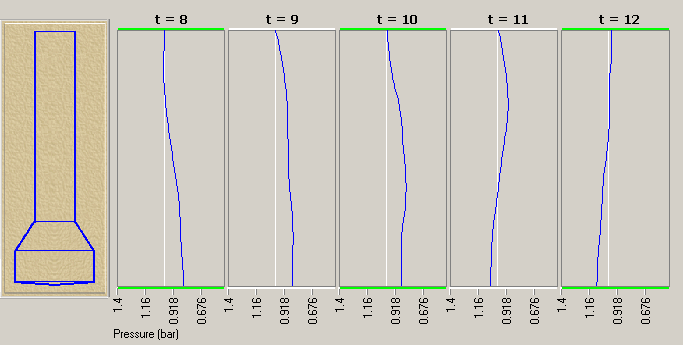|
The Non-Mathematician's Guide To
Basic Valveless Pulsejet Theory
© 2008 Larry Cottrill
by Larry Cottrill 25 Sep 2008
Subtopic 03.02
Kadenacy "Hangs Ten"
Like any Big Kahuna on Maui, the Kadenacy action "rides the wave" -- but in this case, the wave is a
region of pressure that moves through the air, exactly like a "sound" or "acoustic" wave traveling
from a loudspeaker to your ear. This moving region of pressure is, in fact, the only propelling force
for the air that is pumped in and out of the vessel. Unlike the magnificent Hawaiian surf, these waves
are totally massless, and move through the air in the vessel at Mach 1.0 speed (the speed of sound at
the air temperature the wave encounters). Note, however, that this does NOT mean that the air itself
is moved at this kind of speed! In fact, actual air mass motion is MUCH slower than the wave motion.
Because of this "discrepancy", some people conclude that the wave motion and mass motion are totally
unrelated -- but, nothing could be further from the truth!
We might tend to think that in our flashlight-shaped pumping vessel, the air in the entire vessel
changes pressure together (as it seems to do when we're inflating a balloon). But in fact, we can
unequivocally state that it is impossible for air to behave in this way. We can find a
clue to this by looking at our .02 second graph again, but this time superimposing a graph of the
pressure as it changes at a point some distance into the long pipe (shown as the orange curve below):

The important thing to notice here is that the orange curve is "right shifted" in relation to the
blue curve -- meaning that the peaks and valleys of pressure in the pipe are slightly delayed in
time from their corresponding highs and lows in the chamber. This suggests that the high and
low pressure regions travel through the vessel at some high, but measurable, speed. We can also observe
that the amplitude of the pressure swings is much lower at this point than they are at the front
of the chamber (the blue curve). Their "shape" is also somewhat different (by that, I mean that
the orange curve is not just a "scaled down" model of the blue curve). In fact, I have manually
"smoothed" the orange curve somewhat to make the rightward shift easier to see (more about that
later), but I haven't tried to intentionally "warp" it in any way just to make it fit.
Fortunately, just as it is possible to graph pressure against time for a given point in the vessel
(as shown above), we can graph how pressure changes throughout the entire vessel at varying
points in time. Here is a sequence of time frames showing how pressure regions move through the
vessel. In the drawing, I found it more convenient to orient the vessel vertical, with the time
frames spread out from left to right as time passes. Just keep in mind that each curve represents
the front of the chamber at the bottom and the open end of the pipe at the top. The vertical
white line represents normal outdoor air pressure, defined as 1.0 bar. Values to the left of the
white line are higher than normal pressures; values to the right are lower pressures. (Note: the frames
were arbitrarily selected to illustrate the principle, so the time intervals between frames should
not be taken as uniform or "regular" intervals.) We typically start out (at time t=0) with high
pressure concentrated in the chamber. This high pressure region moves ("traverses") the vessel
rapidly (at the speed of sound) from the chamber to the rear opening, where the excess pressure
seems to suddenly disappear! (at time t=4):

What actually happens at t=4 is that the energy represented by the positive pressure wave has been
transferred to the air just outside the open end of the pipe. This pressure energy immediately
creates a spherical acoustic wave radiating outward from a point about 1/3 of the pipe diameter
beyond the open end of the pipe (this point can be called the pipe's pressure node). If the
power of this radiating wave is low, it is a tiny component of what we perceive as a musical tone;
if the power is very high, we hear it as an explosive "bang" - for example, a tiny component of the
roar of a pulsejet!
What happens next is extremely interesting: The action of the wave energy being dissipated beyond the
end of the pipe creates an immediate pressure drop in the open end of the pipe, and this low pressure
now becomes a wave that starts to traverse the vessel in the opposite direction, from rear to
front! This is often referred to as the negative reflection of the pressure wave by the
open end of the pipe (we'll start where we left off, at t=4):

Note how, as the low pressure wave traverses the vessel, it in effect "pulls" the pressure lower
all along its route -- by the time we get to time t=7, the entire pipe has been pulled to less
than atmospheric pressure! At t=8, the low pressure has been concentrated in the chamber part
of the vessel, in essence a "mirror image" of the conditions at time t=0! (Note, however, that
the magnitude of the pressure curve is smaller, due to losses encountered in the process.)
This is where we are at the exact halfway point in the acoustic cycle.
Unlike a wave arriving at an open end, the energy now represented by pressure at the chamber front
end has no place to go but back where it came from. This is the point in the vessel where the highest
magnitude pressure swings will occur and is called the pressure antinode. Because there is no
dissipation of energy at this point, the low pressure wave propagates back through the vessel -- this
is often called the positive reflection of the pressure wave by the closed end of a vessel.
The traverse of the wave resembles the earlier traverse of the high pressure wave, but in reduced
magnitude and "mirror image" form (starting where we left off at t=8):

A careful comparison of the low pressure and high pressure phases of the cycle will show that
the action is not absolutely identical. Note especially that in the low pressure phase, the
pressure in the chamber actually swings positive even before the low part of the wave reaches
the open end of the chamber. (This is because air has actually been moved forward in the
vessel by this point in time -- evidence of the "pumping action" of the vessel.) However,
the physical principles are exactly the same for the low pressure wave; it will undergo
"negative reflection" from the open end of the pipe in the final part of the cycle. So, by
the time the cycle is complete (time t=16), the pressure layout in the vessel is restored
in a pattern remarkably similar to the starting condition (time t=0):

From this point, the entire cycle is ready to repeat -- that is, time t=16 actually becomes
time t=0 for the next cycle!
So, what we have seen is the creation of a concentrated low-pressure
zone, from nothing but the natural physical process begun by initially setting up a high-pressure
zone and allowing this pressure to be relieved by somewhat restricted flow to the outside of the
vessel; then, we've seen how this automatically results in partial restoration of the original
pressure in the very same zone of the vessel. This automatic cycle of pressure variation is
precisely what we mean when we talk about "Kadenacy action" or the "Kadenacy effect". The
movement of air out of and into the vessel to accomplish these pressure changes is sometimes
referred to as "Kadenacy breathing".
Every different shape of acoustic device will have a different form of these pressure curves;
yet, the underlying principle of "Kadenacy breathing" is exactly the same as we see here.
The overall volume and length of the device (and the local density of the air) determine the
basic duration of this alternating high and low pressure cycle, and thus the operating frequency
of the device. In our graphic examples, there are about 6.75 cycles in the .02 second sampling
time, so the cycle duration is:
T = 0.02 / 6.75 = 0.00296 second
And the frequency is 1.0 divided by this duration:
f = 1.0 / T = 1.0 / 0.00296 = 337.5
cycles/sec (or, 337.5 Hz)
(This frequency lies clearly within the audible range of humans, and is about the frequency of
some small pulsejet engines.)
The exact shape of the pressure wave as it transitions into the air at
the open end determines what we perceive as the "voice" or tonality of the sound (and that
wave shape is determined by the precise shaping of the acoustic vessel). Thus, we can distinguish
the tones of an oboe from those of a clarinet, even if we hear them play the very same
sequence of notes.
There are only two fundamental physical differences between a musical wind instrument and a valveless
pulsejet engine: The pressure swings in the pulsejet are fairly large, as shown in the graphic examples
(in a musical instrument, the pressure swings are tiny); and, the interior of most of the engine maintains
an extremely high air temperature throughout the cycle (in an instrument, the temperature is essentially
the same as the outside air). The main functional difference is that in the jet we need to move
significant air mass to realize power development (vastly greater pumping action than in even a huge
organ pipe). So far, all we've looked at is pressure -- but that is just the driving force
behind mass motion. In the next subtopic, we'll try to see how pressure really works to make air move.
Next subtopic:
Power To the Masses!
Go back to select another subtopic
|